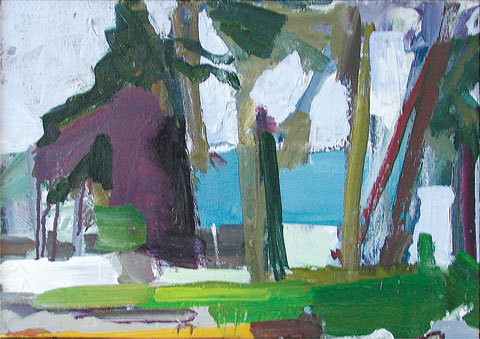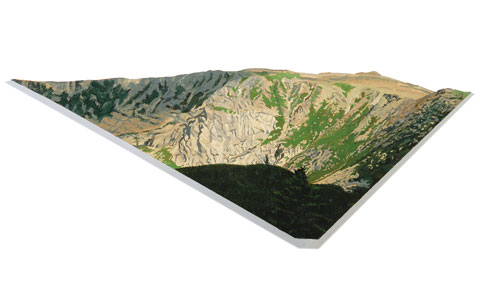
‘BLUE TARP’ Elizabeth Woodworth, oil on canvas, 2001. |
For a few generations now there's been a current of artistic intellectual seriousness in coastal Maine lying obscured beneath the fog of Wyeth popularity and other clichés that fill the galleries, restaurant walls, and roadside stands. Those of us who live here even part of the year are used to elbowing our way through the lobster boats to get to the genuine article.
Two shows featuring regular fixtures of the midcoast summer residents as well as a few full-timers seem to me to have a familiar but a bit unusual resonance in that regard, while also providing something of a lesson in real, as opposed to received, history. The shows are the four artists gathered together in the two floors of the Caldbeck Gallery in Rockland and the forty-odd artists that at one time or another studied with Lois Dodd, whose work has been gathered for the show "Lois Dodd and Her Students" at the Firehouse Center for the Falcon Foundation in Damariscotta.
In 1954, when both Lois Dodd and Nancy Wissemann-Widrig started showing, if you had an interest in modernist ideas the imperative was toward abstraction, as if the previous half-century of Western art was a progressive evolution toward something other than representation. There were then, as now, plenty of holdouts who enjoy demonstrating their skill in mimesis, but there were also a number of people who thought that the thoroughgoing understanding of the self-referential nature of art that was part of the development of modernist ideas could be used in representation. Among these was, perhaps most notably, Fairfield Porter and, perhaps less well known then but important to our purposes, both Dodd and Wissemann-Widrig.

‘GREAT BASIN, KATAHDIN’ Oil on cutout canvas mounted on wood, by Sam Cady, 2010. |
The show at the Caldbeck Gallery features the work of Wissemann-Widrig, David Dewey, and John Silvero on the second floor with Sam Cady filling the first.
Sam Cady inhabits a conceptual zone that is rooted in both modernist thought and the traditional Maine seashore and landscape painting. His carefully rendered islands or bits of shore are big cutouts — the wall they hang on is itself a background. He does this with a sense of visual balance that makes them animated and solid. Here he shows a segment of a Friendship sloop, views of the shore, an early view of a house trailer, and a snow-covered wharf on painted cutout metal. Cady is from a younger generation than Dodd and Wissemann-Widrig, but their underlying ideas have concordant resonance — you are looking at a representation that reveals itself as an abstraction. Cady's work is arresting, and when you see it you look at things differently afterward.
For years Nancy Wissemann-Widrig has painted those parts of the shore that are usually overlooked, the reeds and rocks, say, in close-up. In recent years her work has gotten odder and more personal, almost dreamlike. The paintings are populated by shells, marks, and objects in bright, dreamlike colors, as if she were creating an image of an inner world, a picture of a dream time. They are clearly the result of a long lifetime lived creatively and thoughtfully, with unusual attention to what she sees and how she relates her experience in her work. I've been looking at her paintings now for close to forty years, and these pictures are different but still manifestly hers, an evolution.